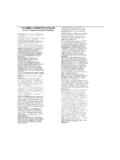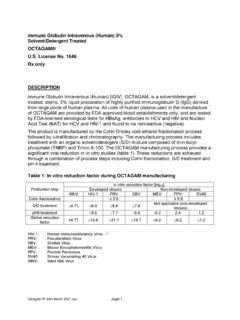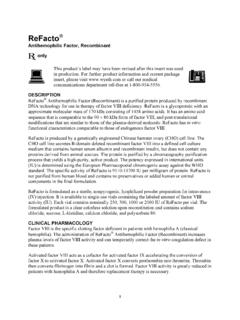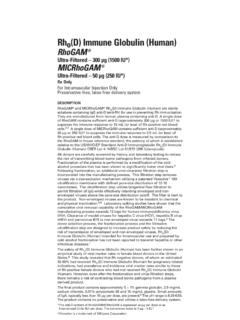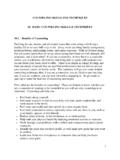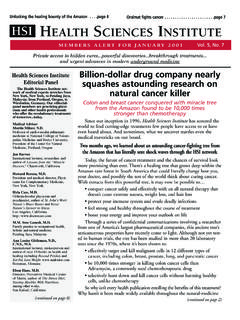Transcription of Rh (D) Immune Globulin (Human) - …
1 DESCRIPTIONRhoGAM and MICRhoGAM Rho(D) Immune Globulin (Human) are sterilesolutions containing IgG anti-D (anti-Rh) for use in preventing Rh are manufactured from human plasma containing anti-D. A single doseof RhoGAM contains sufficient anti-D (approximately 300 g or 1500 IU)* tosuppress the Immune response to 15 mL (or less) of Rh-positive red ,3A single dose of MICRhoGAM contains sufficient anti-D (approximately50 g or 250 IU)* to suppress the Immune response to mL (or less) of Rh-positive red blood cells. The anti-D dose is measured by comparison tothe RhoGAM in-house reference standard, the potency of which is establishedrelative to the US/WHO/EP Standard Anti-D Immunoglobulin Rho(D) ImmuneGlobulin (Human) CBER Lot 4: NIBSC Lot 01/572 (285 IU/ampoule).All donors are carefully screened by history and laboratory testing to reducethe risk of transmitting blood-borne pathogens from infected of the plasma is performed by a modification of the coldalcohol procedure that has been shown to significantly lower viral fractionation, an additional viral-clearance filtration step isincorporated into the manufacturing process.
2 This filtration step removesviruses via a size-exclusion mechanism utilizing a patented Viresolve 180ultrafiltration membrane with defined pore-size distribution of 12-18nanometers. The ultrafiltration step utilizes tangential flow filtration topermit filtration of IgG while effectively retarding enveloped and non-enveloped viruses above the pore-size distribution cutoff. The filter is inert tothe product. Non-enveloped viruses are known to be resistant to chemicaland physical ,6 Laboratory spiking studies have shown that thecumulative viral removal capability of the RhoGAM/MICRhoGAMmanufacturing process exceeds 13 logs for human immunodeficiency virus(HIV). Clearance of model viruses for hepatitis C virus (HCV), hepatitis B virus(HBV) and parvovirus B19 (a non-enveloped virus) exceeds 11 selection process, the fractionation process and the Viresolveultrafiltration step are designed to increase product safety by reducing therisk of transmission of enveloped and non-enveloped viruses.
3 Rho(D) Immune Globulin (Human) intended for intramuscular use and prepared bycold alcohol fractionation has not been reported to transmit hepatitis or otherinfectious safety of Rho(D) Immune Globulin (Human) has been further shown in anempirical study of viral marker rates in female blood donors in the study revealed that Rh-negative donors, of whom an estimated55-60% had received Rho(D) Immune Globulin (Human) for pregnancy-relatedindications, had prevalence and incidence viral marker rates similar to thoseof Rh-positive female donors who had not received Rho(D) Immune Globulin (Human). However, even after the fractionation and virus-filtration steps,there remains a risk of contracting blood-borne pathogens from a plasma-derived final product contains approximately 5 1% gamma Globulin , mg/mLsodium chloride, polysorbate 80 and 15 mg/mL glycine.
4 Small amountsof IgA, typically less than 15 g per dose, are pH range is product contains no preservative and utilizes a latex-free delivery system.*The anti-D content of RhoGAM/MICRhoGAM is expressed as g per dose or asInternational Units (IU) per dose. The conversion factor is 1 g = 5 (D) Immune Globulin (Human)RhoGAM Ultra-Filtered 300 g (1500 IU*)MICRhoGAM Ultra-Filtered 50 g (250 IU*)Rx OnlyFor Intramuscular Injection OnlyPreservative-free, latex-free delivery system Viresolve is a trademark of Millipore Corporation. CLINICAL PHARMACOLOGYM echanism of ActionRhoGAM and MICRhoGAM act by suppressing the Immune response of Rh-negative individuals to Rh-positive red blood cells. The mechanism ofaction is unknown. RhoGAM, MICRhoGAM and other Rho(D) ImmuneGlobulin (Human) products are not effective in altering the course orconsequences of Rh immunization once it has UseThe Rh-negative obstetrical patient may be exposed to red blood cells fromher Rh-positive fetus during the normal course of pregnancy or afterobstetrical procedures or abdominal trauma.
5 Clinical studies have proventhat the incidence of Rh immunization as a result of pregnancy wasreduced to 1-2% from 12-13% when RhoGAM was given within 72 hoursfollowing ,11 Antepartum administration of Rh Immune globulinat 28 weeks, as well as within 72 hours of delivery, has been shown toreduce the Rh immunization rate to about ,13 Clinical studies demonstrated that administration of MICRhoGAM within threehours following abortion was 100% effective in preventing Rh after Rh Incompatible TransfusionAnRh-negative individual transfused with one unit of Rh-positive red bloodcells has about an 80% likelihood of producing , Rhimmunization can occur after exposure to < 1 mL of Rh-positive red bloodcells. Protection from Rh immunization is accomplished by administeringthe appropriate dose of RhoGAM or MICRhoGAM, which is >20 g per mLof Rh-positive red blood cells, within 72 hours of transfusion ofincompatible red ,15(See DOSAGE AND ADMINISTRATION section.)
6 Pharmacokinetic PropertiesPharmacokinetic studies after intramuscular injection were performed oneight Rh-negative subjects received a single dose (300 g)of RhoGAM, while two subjects received four doses (1200 g). Plasmaanti-D levels were monitored for four months using a validated methodwith sensitivity of approximately 1 ng/mL. The parameters measuredand/or calculated included the following:Cmax=maximum plasma concentration obtained (ng/mL)Tmax= time to attain Cmax (days)T1/2= elimination half-life (days)Vd= volume of distribution (liters)Mean Pharmacokinetic Parameters for RhoGAMP arameterSingle DoseFour DosesDose Ratio(n = 6)(n = 2)(1/4) AND USAGEP regnancy and Other Obstetrical Conditions in Rh-Negative Women,Unless the Father or Baby are Conclusively Rh Negative Pregnancy/delivery of an Rh-positive baby irrespective of the ABO groupsofthe mother and baby Abortion/threatened abortion at any stage of gestation Ectopic pregnancy Antepartum fetal-maternal hemorrhage (suspected or proven) resultingfrom antepartum hemorrhage ( , placenta previa), amniocentesis,chorionic villus sampling, percutaneous umbilical blood sampling, otherobstetrical manipulative procedure ( , version)
7 Or abdominal trauma Transfusion of Rh incompatible blood or blood products Transfusion Prevention of Rh immunization in any Rh-negative person afterincompatible transfusion of Rh-positive blood or blood products ( , red blood cells, platelet concentrates, granulocyte concentrates)CONTRAINDICATIONSI ndividuals known to have had an anaphylactic or severe systemic reactionto human Globulin should not receive RhoGAM, MICRhoGAM or any otherRho(D) Immune Globulin (Human).WARNINGSRhoGAM and MICRhoGAM are made from human plasma. Because theseproducts are made from human blood, they may carry a risk oftransmitting infectious agents, , viruses, and, theoretically, theCreutzfeldt-Jakob disease (CJD) agent. The risk that such products willtransmit an infectious agent has been reduced by screening plasmadonors for prior exposure to certain viruses, by testing for the presence ofcertain current virus infections and by removing certain viruses during themanufacturing process.
8 Following fractionation, an additional viral-clearancefiltration step is incorporated into the manufacturing process. Thisfiltration step removes viruses via a size-exclusion mechanism utilizing apatented Viresolve 180 ultrafiltration membrane with a defined pore-sizedistribution of 12-18 nanometers. The filter is inert to the product. Thisvirus removal process has been shown in laboratory spiking studies toreduce the levels of some viruses ranging from 18-200 nanometers in size,including enveloped viruses as well as non-enveloped of theabove steps are designed to increase product safety by reducing the riskoftransmission of lipid-enveloped and non-lipid-enveloped these measures, such products can still potentially transmitdisease. There is also the possibility that unknown infectious agents maybe present in such products. ALL infections thought by a physicianpossibly to have been transmitted by these products should be reportedby the physician or other healthcare provider in the United States toOrtho-Clinical Diagnostics, Inc.
9 At 1-800-421-3311. Outside the UnitedStates, the company distributing these products should be contacted. Thephysician should discuss the risks and benefits of these products with thepatient. RhoGAM and MICRhoGAM are manufactured and distributed byOrtho-Clinical Diagnostics, Inc., Raritan, NJ use only. Do not inject RhoGAMor MICRhoGAMintravenously. In the case of postpartum use, the product is intended formaternal administration. Do not inject the newborn should be observed for at least 20 minutes after responses to RhoGAM or MICRhoGAM may occur. Patients shouldbe informed of the early signs of hypersensitivity reactions, includinghives, generalized urticaria, tightness of the chest, wheezing, hypotensionandanaphylaxis. The treatment depends upon the nature and severity ofthe and MICRhoGAM contain a small quantity of IgA (less than 15 gper dose).
10 9 Although high doses of intravenous immunoglobulincontaining IgA at levels of 270-720 g/mL have been given without incidentduring treatment of patients with high-titered antibodies to IgA,17theattending physician must weigh the benefit against the potential risks ofhypersensitivity presence of passively acquired anti-D in the maternal serum maycause a positive antibody screening test. This does not preclude furtherantepartum or postpartum babies born of women given Rho(D) Immune Globulin (Human)antepartum have weakly positive direct antiglobulin (Coombs) tests at hemorrhage may cause false blood typing results in the in pregnancy or following delivery, there may be sufficient fetal Rh-positive red blood cells in the circulation of the Rh-negative mother tocause a positive antiglobulin test for weak D (Du). When there is any doubt asto the patient s Rh type, RhoGAM or MICRhoGAM should be Category CAnimal reproduction studies have not been conducted with RhoGAM orMICRhoGAM.

